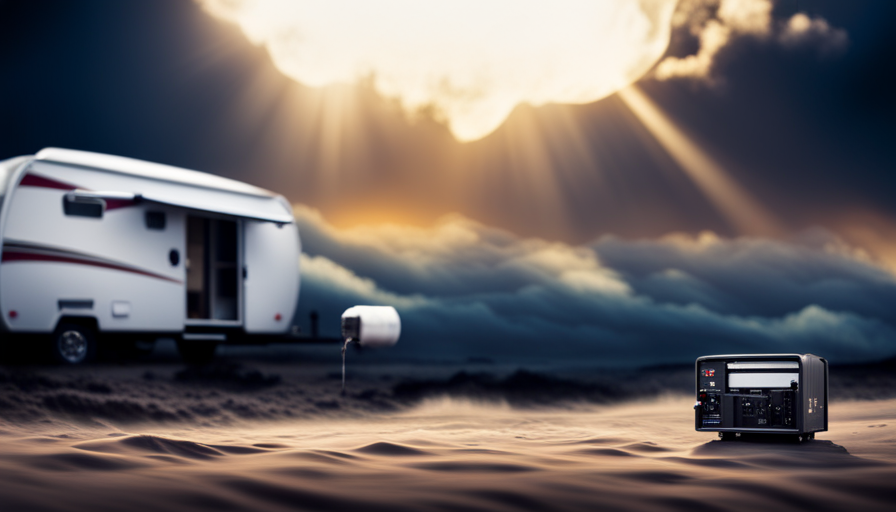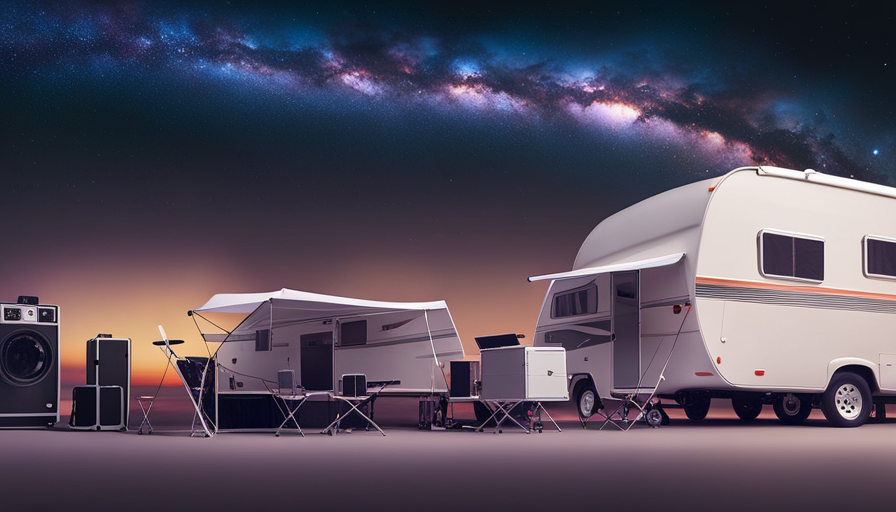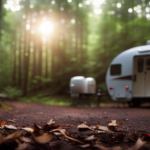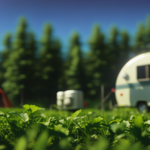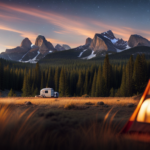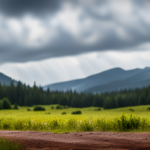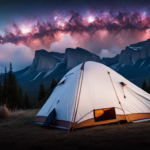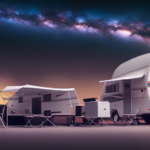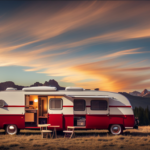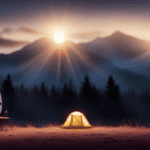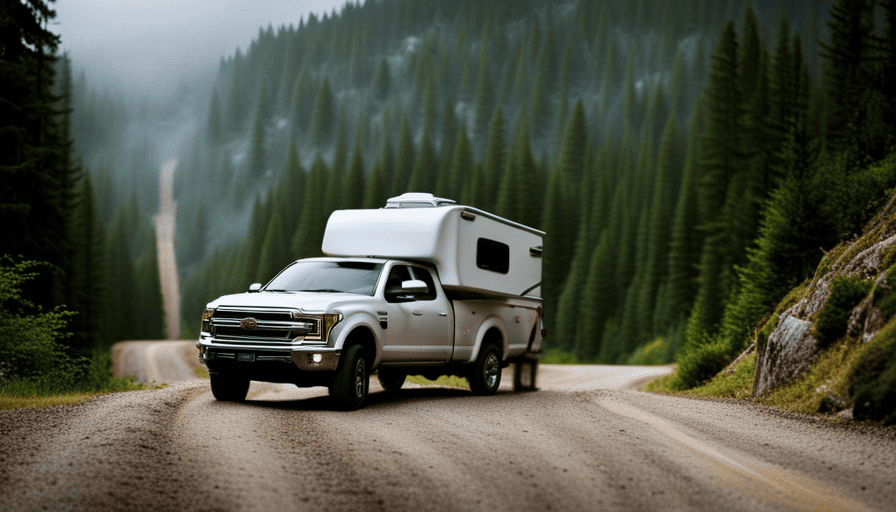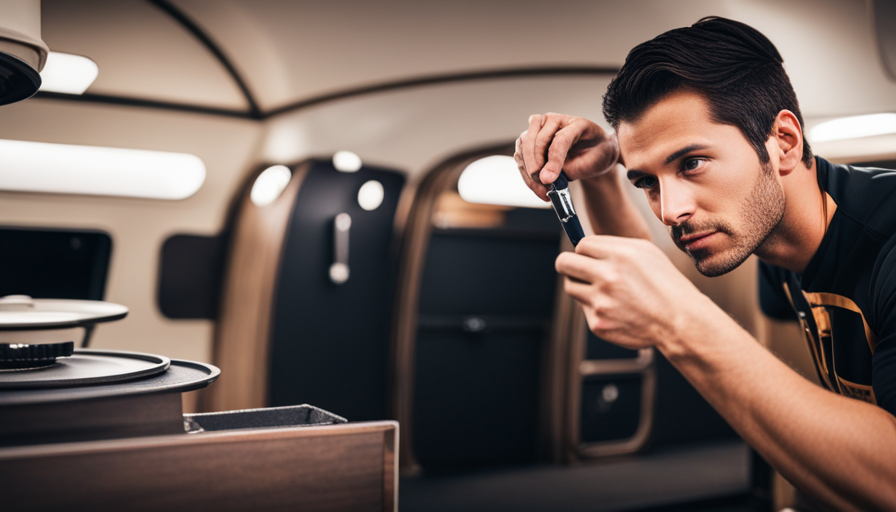Are you eager to spend time outdoors and experience an unforgettable camping trip? Before heading out with your camper, it’s important to consider bringing along a generator. Generators are essential for providing power during outdoor adventures. But how do you choose the right size generator for your camper? Don’t worry, we’re here to help you make this important decision.
In this article, we will delve into the intricate world of generators, exploring the factors to consider when selecting the perfect size for your camper. From assessing power needs to evaluating noise levels and additional features, we leave no stone unturned.
So, gather ’round, outdoor enthusiasts, as we embark on this enlightening journey to find the ideal generator for your camper.
Key Takeaways
- Choosing the right size generator for a camper is crucial for meeting power consumption needs and ensuring a peaceful camping experience.
- Factors to consider when selecting the perfect size generator include power output, fuel consumption, noise level, and portability.
- Proper ventilation and secure installation are important for safe use of a generator in a camper.
- Regular maintenance, customer reviews, and expert guidance are essential for optimal performance and reliability of a generator.
Determine Your Power Needs
You’ll need to figure out how much power you’ll be using in your camper to understand what size generator you’ll need. One of the most important factors in determining your power needs is the appliances and electronics you plan to use while camping. For example, air conditioning units, refrigerators, and portable camper heaters all consume different amounts of power. It’s important to add up the wattage of each item to get an accurate estimate of your power usage. This will help you choose a generator that can handle the load and keep your camping experience comfortable and convenient.
To determine your power needs, you’ll have to consider your power consumption and calculate your wattage requirements. Power consumption refers to the amount of electrical energy your appliances and devices will need to operate. Each electronic item in your camper will have a power rating in watts, which indicates the amount of power it consumes.
To calculate your wattage requirements, add up the power ratings of all the appliances and devices that you plan to use simultaneously. This will give you an estimate of the total power you’ll need. Keep in mind that some appliances may have a higher power requirement during startup or initial operation.
Once you have determined your power needs, you can then choose the right generator type that can meet those requirements. This will ensure that you have enough power to run all your essential devices and appliances while on the road.
Choose the Right Generator Type
Make sure to select the appropriate type of power source for your mobile home to ensure efficient energy supply. When choosing a generator, it’s important to evaluate fuel consumption and compare different generator brands to ensure you make the right choice. Evaluating fuel consumption is crucial because it determines how long your generator will run before needing a refill. This is especially important when you’re camping in remote areas where fuel availability may be limited.
Comparing different generator brands allows you to find the one that best suits your needs in terms of reliability, durability, and ease of maintenance. There are various types of generators available in the market, such as gasoline, propane, and diesel generators.
Gasoline generators are commonly used due to their affordability and availability. Propane generators are a cleaner option and are often preferred for their lower emissions. Diesel generators are known for their fuel efficiency and are a popular choice for larger campers.
Consider the generator’s power output, which we’ll discuss in the next section, to ensure that it’s capable of meeting your energy needs.
Consider the Generator’s Power Output
To fully enjoy your mobile home experience, it’s important to consider the power output of your chosen generator. Evaluating the fuel consumption and comparing the power output to the appliances used will help ensure that you have enough power to meet your needs while on the road.
When evaluating the fuel consumption of a generator, it’s essential to look at how much fuel it consumes per hour. This information can usually be found in the generator’s specifications or user manual. By knowing the fuel consumption rate, you can estimate how long the generator will run on a full tank and plan accordingly.
Another crucial aspect to consider is the power output of the generator. You’ll need to compare the generator’s power output to the appliances you plan to use in your camper. Look at the wattage requirements of each appliance and add them up to determine the total power output needed. Make sure the generator you choose has a power output that exceeds this total to ensure everything runs smoothly.
Assessing the noise level of a generator is the next step in finding the right one for your camper. By considering these factors, you can make an informed decision and find a generator that meets your power needs while keeping noise levels to a minimum.
Assess the Noise Level
When considering a generator for your camper, it’s important to assess the noise level. Opting for a quiet generator will help avoid disturbing the tranquility of nature and the enjoyment of fellow campers.
To determine the noise level, it’s crucial to check the decibel rating of different generator models. This will provide valuable information on how loud the generator will be during operation.
Opt for a quiet generator to avoid disturbing your camping experience
Choose a quiet generator so that you don’t disrupt the tranquility of your camping experience. Opting for a quiet generator offers numerous benefits.
First, it ensures peaceful surroundings, allowing you to fully enjoy nature without the loud noise that can disturb both you and neighboring campers.
Second, a quiet generator reduces the risk of attracting unwanted attention from wildlife, as animals are sensitive to loud noises.
Additionally, a quiet generator eliminates the need for ear protection, making your camping experience more comfortable and enjoyable.
When choosing the right generator size, consider the power requirements of your camper and the appliances you plan to use.
It is important to check the decibel rating of different generator models to find one that operates at a low noise level.
By selecting a quiet generator, you can ensure a serene camping experience without disturbing the peace and quiet of the great outdoors.
Check the decibel rating of different generator models
Make sure to listen closely to the decibel rating of various generator models, as it’ll be the key that unlocks the door to a peaceful camping experience.
When comparing prices and considering fuel options, it’s important to also consider the noise level produced by the generator. Generators with lower decibel ratings produce less noise, making them ideal for camping trips where tranquility is desired. By opting for a quiet generator, you can enjoy the serenity of nature without any disturbances.
Additionally, quieter generators are less likely to bother neighboring campers, allowing everyone to have a pleasant camping experience.
Evaluating the size and weight of the generator is the next step in finding the perfect fit for your camper.
Evaluate the Size and Weight
When evaluating the size and weight of a generator for our camper, we need to consider the portability and storage options.
It is important to determine if we have enough space in our camper for the generator. We should carefully assess the dimensions and weight of different generator sizes to ensure it will meet our needs without sacrificing valuable space or adding excessive weight to our camper.
Consider the portability and storage options of different generator sizes
If you’re thinking about getting a generator for your camper, it’s worth considering how portable and easy to store different sizes can be. When it comes to portable generator options, there are various sizes to choose from.
Smaller generators, such as the 1,000-watt models, are generally more lightweight and compact, making them easier to transport and store. These smaller generators can fit easily in the trunk of a car or even in the storage compartment of your camper.
On the other hand, larger generators, like the 4,000-watt models, tend to be bulkier and heavier. They may require more effort to move around and take up more space in your camper. Therefore, it’s crucial to assess the portability and storage solutions for generators before making a decision.
When determining if you have enough space in your camper for the generator, you need to consider the size and weight of the generator along with the available storage options.
Determine if you have enough space in your camper for the generator
Ensure you have enough room in your camper to comfortably accommodate the portable power source. When considering the installation of a camper generator, it’s important to take into account the available space and any potential challenges that may arise.
Common challenges in fitting a generator in a camper include limited storage compartments, restricted access to ventilation, and the need for secure mounting to prevent movement during travel. To overcome these challenges, it’s recommended to choose a generator size that fits within the available space and consider options such as portable generators that can be stored outside the camper.
Additionally, it’s crucial to ensure proper ventilation and secure installation to avoid any potential hazards.
With these camper generator installation tips in mind, let’s now move on to checking the runtime and fuel efficiency of the generator.
Check the Runtime and Fuel Efficiency
To determine the appropriate size generator for your camper, consider checking the runtime and fuel efficiency. You don’t want to end up with a generator that runs out of fuel quickly or consumes too much fuel, leaving you stranded in the middle of nowhere. In addition to runtime and fuel efficiency, it’s important to consider the power requirements of your camper. Choosing the right generator for your 30 ft camper involves calculating the total wattage of all the appliances and electronics you plan to use. It’s also a good idea to consult with a professional to ensure you select a generator that can adequately meet your power needs without being excessive.
Think of it like a marathon runner who carefully monitors their energy levels and fuel intake to ensure they can finish the race without running out of steam.
When it comes to runtime, you need to know how long the generator can operate on a full tank of fuel. This will depend on factors such as the generator’s fuel consumption and the size of its fuel tank. Generators with higher fuel consumption will require more frequent refueling, which can be a hassle during outdoor adventures.
Additionally, generators with larger fuel tanks will provide longer runtimes, allowing you to enjoy your camping trip without interruptions.
Fuel efficiency is equally important. A generator that consumes too much fuel not only adds to your expenses but also increases the frequency of refueling. Look for generators that are designed to be fuel-efficient, as they can help you save money and minimize maintenance requirements.
Consider additional features and safety measures in the next section, as they can enhance your camping experience and provide peace of mind.
Consider Additional Features and Safety Measures
When considering additional features and safety measures for a generator, we should look for models that have automatic shutoff features. This is important because it helps prevent the generator from running when it’s not needed, saving fuel and reducing the risk of accidents.
Additionally, it’s a good idea to consider generators with built-in surge protectors or voltage regulation to protect sensitive electronics and appliances from power surges or fluctuations.
Look for generators with automatic shutoff features
Look for generators that have automatic shutoff features to ensure safe and convenient power supply for your camper. Generator safety is of utmost importance when it comes to powering your camper. Automatic shutoff features provide numerous benefits, such as protecting the generator from damage caused by overload or overheating. This feature allows the generator to automatically shut off when the power demand exceeds its capacity or when it reaches a certain temperature threshold, preventing potential accidents or malfunctions.
By incorporating automatic shutoff features into your generator, you can have peace of mind knowing that it will operate safely and efficiently. Additionally, consider generators with built-in surge protectors or voltage regulation to further safeguard your camper’s electrical system. These features will help protect your appliances and electronics from voltage spikes or fluctuations. This ensures a stable and reliable power supply for your camper, preventing any potential damage.
Consider generators with built-in surge protectors or voltage regulation
Consider generators with built-in surge protectors or voltage regulation in order to ensure a stable and reliable power supply for your camper, providing an unparalleled level of electrical safety.
-
Built-in surge protectors vs. external surge protectors:
-
Built-in surge protectors offer convenience and eliminate the need for additional equipment.
-
External surge protectors can be upgraded or replaced separately if necessary.
-
Both options help protect your camper’s electrical system from voltage spikes and surges.
-
Benefits of generators with voltage regulation:
-
They maintain a consistent power output, preventing damage to sensitive electronics.
-
They ensure a steady flow of electricity, avoiding fluctuations that could affect appliances.
-
Drawbacks of generators without voltage regulation:
-
Inconsistent power output can cause issues with devices and appliances.
-
Sudden power surges or drops can damage electrical components.
Regular maintenance is crucial for generators to perform optimally. Follow these tips and best practices:
- Regularly check and clean the air filter and fuel system.
- Change the oil and spark plug according to the manufacturer’s recommendations.
By considering generators with built-in surge protectors or voltage regulation, you can ensure a reliable power supply for your camper. Now, let’s move on to the next section and read customer reviews and recommendations.
Read Customer Reviews and Recommendations
To get the scoop on the best generator for your camper, take a peek at the customer reviews and recommendations – they’ll give you some invaluable insights! When it comes to customer satisfaction, there’s no better way to gauge the performance and reliability of a generator than by hearing from those who’ve already used it.
Reading customer reviews allows you to learn about their firsthand experiences with different generators, including any issues they may have encountered and how they were resolved. This can help you make an informed decision and avoid potential pitfalls.
In addition to customer satisfaction, reviews also provide useful information about generator maintenance. Customers often share tips and tricks for keeping their generators in top shape, such as proper cleaning and regular oil changes. They may also mention any specific maintenance requirements or common issues to look out for. These insights can be invaluable in ensuring that your generator stays in optimal condition and continues to perform well throughout your camping adventures.
Now that you’ve gathered some knowledge from customer reviews and recommendations, it’s time to set a budget for your generator purchase. By considering your needs and weighing them against the available options, you can find a generator that fits both your camping requirements and your wallet.
Set a Budget
Once you’ve gathered insights from customer reviews and recommendations, it’s crucial to establish a budget that aligns with your camping needs and financial constraints. Setting a budget will help you narrow down your options and ensure you get the most suitable generator for your camper.
To set a budget effectively, follow these steps:
-
Determine Power Requirements: Before setting a budget, it’s essential to determine the power requirements of your camper. Consider the appliances and devices you’ll be using, such as air conditioning units, refrigerators, or microwaves. Calculate their power consumption to get an estimate of the generator size you need.
-
Research Generator Prices: Take the time to research different generator models and their prices. Compare prices from various retailers and online platforms to get an idea of the average cost for generators that meet your power requirements.
-
Consider Long-Term Value: While it may be tempting to opt for a cheaper generator, it’s important to consider the long-term value. Investing in a higher-quality generator may save you money in the long run, as it’ll be more reliable and require fewer repairs or replacements.
Once you’ve set a budget and determined your power requirements, you can move on to the next step of consulting with an expert to ensure you make an informed decision.
Consult with an Expert
If you’re feeling overwhelmed by the options and unsure of which direction to take, consulting with an expert can provide you with invaluable advice and guidance.
When it comes to choosing the right generator for your camper, there are various generator brands available in the market. Consulting with an expert can help you narrow down your options and select a generator brand that is reliable and suitable for your specific needs.
An expert can also provide valuable insights on generator maintenance. Proper maintenance is crucial to ensure that your generator operates efficiently and remains in good condition for a long time. An expert can guide you on the regular maintenance tasks that need to be performed, such as oil changes, filter replacements, and general inspections.
By consulting with an expert, you can gain a deeper understanding of the different generator brands available and how to properly maintain your generator. Their technical knowledge and experience can save you time and money in the long run by helping you make informed decisions and avoid costly mistakes.
So, don’t hesitate to reach out to an expert for their expert advice and guidance on generator selection and maintenance.
Frequently Asked Questions
Can I use a portable generator for my camper?
Yes, we can use a portable generator for our camper. Portable generators offer convenience and versatility, allowing us to power our camper wherever we go.
While built-in generators are specifically designed for campers, portable generators provide a cost-effective alternative. However, it’s important to consider the noise level of portable generators, as they can be louder compared to built-in generators. So, it’s essential to choose a portable generator with a noise level that is acceptable for camping.
Are there any specific safety measures I need to consider when using a generator in my camper?
When using a generator in our camper, it’s crucial to prioritize generator safety and maintenance.
To ensure safety, we should always follow the manufacturer’s instructions. For example, keep the generator outside and away from windows or vents to prevent carbon monoxide poisoning.
Regular maintenance is also essential for optimal performance and longevity. This includes checking fuel levels and changing oil.
By adhering to these safety measures and maintaining our generator, we can enjoy a worry-free camping experience.
What are the additional features that I should look for when choosing a generator for my camper?
When choosing a generator for our camper, we need to consider additional features that enhance functionality and convenience.
Firstly, an electric start feature allows for easy ignition, saving us from the hassle of manual starting.
Secondly, an automatic voltage regulator ensures a stable power output, protecting our camper’s sensitive electronics.
Lastly, a fuel gauge helps us monitor the generator’s fuel level and plan refueling accordingly.
These features are crucial in selecting the right generator for our camper.
How do I determine the appropriate wattage for my camper’s power needs?
When determining the appropriate wattage for your camper’s power needs, it’s crucial to consider the electrical appliances and devices you plan to use. Start by making a list of all the items you’ll use simultaneously, noting their wattage requirements.
Add up the total wattage to determine the minimum generator size needed. Remember to account for any additional power needs in case of future upgrades or changes in usage.
Properly determining wattage ensures your generator can adequately meet your camper’s power demands.
Are there any specific maintenance requirements for generators used in campers?
When it comes to maintaining generators used in campers, there are specific maintenance requirements that should be followed. Regularly checking and changing the oil, air filter, and spark plug is essential.
It’s also important to keep the generator clean and free from debris. Common problems that can arise include fuel contamination, battery issues, and spark plug malfunctions.
Performing routine maintenance will ensure the generator operates efficiently and prolong its lifespan.
Conclusion
In conclusion, choosing the right size generator for your camper is crucial to ensuring a comfortable and hassle-free camping experience. By carefully considering your power needs, generator type, power output, noise level, size, weight, additional features, and budget, you can make an informed decision.
Remember to consult with an expert and read customer reviews for valuable insights. So, whether you’re embarking on a serene camping trip or exploring the great outdoors, finding the perfect generator will provide the necessary power to fuel your adventures.

